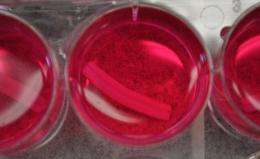Students mimic blood flow in the lab

If by chance you should have a stent inserted in a clogged coronary artery, you can probably count on it staying around for a very long time. So it’s important to know what will happen to it.
“But there’s not a lot of information on exactly how stents degrade in the body,” said Patrick Bowen, who just completed his BS in Materials Science and Engineering at Michigan Technological University. What information there is, on stents and other devices that surgeons place inside us for our own good, has been derived from studies on large animals, which are expensive and time-consuming.
That information may now be more forthcoming. Bowen is part of an interdisciplinary Senior Design team that found a couple of new ways to replicate what happens to stents and other manmade things tucked inside our blood vessels.
First, the group implanted tiny wires in the aortas of rats and tracked what happened to the material. Over time, the wires became coated with a layer of calcium and phosphorus and then were gradually covered by a layer of cell tissue.
The students then concocted a mixture of fibrin (a protein involved in blood clotting) and a cell culture medium chemically similar to blood. Next they put iron and magnesium wires in the mix. “Then they subjected it to circulatory flow,” said Jeremy Goldman, an associate professor of biomedical engineering and the team’s co-advisor. “Essentially, we tried to place the candidate stent material into a simulated artery.”
The wires in the fibrin mixture corroded in exactly the same way as the wires in the rats. “In the past, in vivo and in vitro corrosion rates have always been different,” said Jaroslaw Drelich, an associate professor of materials science and engineering and the group’s other co-advisor. “These appear to be identical.”
If their slurry is as good a mimic as these initial tests suggest, the team’s work has major implications for scientists.
“The rat model could help reduce reliance on large animals. And the students’ in vitro model might make it possible to reduce the use of animals overall,” Goldman said.
In other words, said Bowen, “We could save a lot of pigs and rabbits, and companies could save a lot of money.”
The Senior Design team has been funded by Boston Scientific, a designer and manufacturer of implantable medical devices, including stents. In particular, they are investigating bioabsorbable stents, which would be gradually absorbed into the body over time. So far, the company has been impressed with the students’ efforts, said Goldman. “They’ve done cutting-edge work. For undergraduates to accomplish this shows a high level of effort and dedication.”
Their success has been due in great part to its interdisciplinary nature, Goldman added. “The project brought together our two departments in a very nice way,” he said.
Senior Design team members, in addition to Bowen, are Rebecca Franke, Judy Bryne, Ellen Pokorney, Jessica Rhadigan and Aaron Tauscher (Biomedical Engineering); and Jesse Gelbaugh (Materials Science and Engineering). The researchers expect to publish a number of papers on the project; two recent graduates, Daniel Pierson and Jacob Edick, are first and second author, respectively on a paper that has been submitted for publication in the Journal of Biomedical Materials Research B: Applied Biomaterials.



















